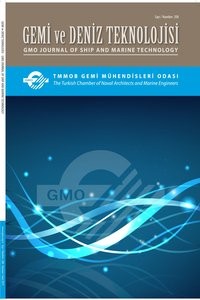Numerical Investigation of the Effects of Underwater Aft Cone Angle and Length-to-Beam Ratio on Hull Efficiency
Öz
The use of submarines in
military, touristic, oceanographic surveys and seashore areas has increased in
recent years. Much of the scientific research in submarine hydrodynamics has
focused on the issues of acoustics and propulsion. One of the most important
differences from the submarine dimensions in determining the propulsion
characteristics is to define the angle of the stern cone. In this study, the
effect of stern cone angle and aspect ratio (L / B) on hull efficiency is
investigated by a computational fluid dynamics method (HAD). DARPA Suboff
submarine is derived for different stern cone and different L / B ratios, so
that displacement volume remains constant. For different submarine geometries,
resistance and propulsive properties were investigated by performing flow
analysis with/without propeller. The effect on the propeller-body interaction
of the stern cone is given as the thrust deduction, the effective wake
coefficient and the hull efficiency.
Anahtar Kelimeler
Submarine Wake coefficient Thrust deduction Hull Efficiency Cone Angle Computational-Experimental Fluid Dynamics
Kaynakça
- Abdel-Maksoud, M., Menter, F., Wuttke, H. (1998). “Numerical Computation of the Series 60 CB=0.6 Ship with Rotating Propeller”, Third Osaka Colloquium on Advanced CFD Applications to Ship Flow and Hull Form Design, Osaka.
- Alin, N., Bensow, R., Fureby, C., Huuva, T. (2010). “Current Capabilities of DES and LES for Submarines at Straight Course”, Journal of Ship Research, Vol. 54, p. 184-196.
- Alin, C., Chapius, M., Fureby, C., Liefvendahl, M., Svennberg, U., Troeng, C. (Eylül, 2010). “A Numerical Study of Submarine Propeller-Hull Interactions”, 28th Symposium on Naval Hydrodynamics Pasadena, A.B.D.
- Burcher R. ve Rydill, L. (1994). “Concepts in Submarine Design”, Cambridge University Press. Lee, S.W., Hwang, Y.S., Ryu, M.C., Kim, I.H., Sin, M.S. (2003) “A Development of 3000 ton Class Submarine and the Study on its Hydrodynamic Performances”, The Thirteenth International Offshore and Polar Engineering Conference, Honolulu, Hawai, A.B.D.
- Castro, A. M., Carrica, P.M., Stern F. (2011).“Full Scale self-propulsion computatipns using discretized propeller for the KRISO container ship KCS”. Computers&Fluids, 51, pp.35-47.
- Chase, N. (2012). “Simulations of the DARPA Suboff Submarine including self-propulsion with the E1619 Propeller”, Master of Science Thesis, University of Iowa.
- Chase, N., Carrica, P. M. (2013). “Submarine Propeller Computations and Application to Self-Propulsion of DARPA Suboff”, Ocean Engineering, Vol. 60, 68-80.
- Chen, H.C., Lee, S.K. (2004). “Time-domain Simulation of Four-quadrant Propeller Flows by a Chimera Moving Grid Approach”, Proc. ASCE Conf. Ocean Eng. İn the Oceans VI, p177.
- Dai, C.M.H., Gorski J.J., Haussling, H.J. (1991). “Computation of an Integrated Ducted Propulsor-stern Performance in Axisymmetric Flow”, Proc. Propeller/shafting 1991 Symposium.
- Di Felice F., Felli M., Liefvendahl M., Svennberg U. (2009). “Numerical and experimental analysis of the wake behavior of a generic submarine propeller”. First International Symposium Marine Propulsors, Trondheim, Norway.
- Groves, N.C., Huang, T.T., Chang, M.S. (1989). “Geometric Characteristics of Darpa Suboff Models”, David Taylor Research Center, Ship Hydromechanics Department, Report Number DTRC/SHD-1298-01.
- Hally, D., Laurens, J.-M. (1998). “Numerical Simulation of Hull-Propeller Interaction Using Force Fields Within Navier-Stokes Computations”, Ship Technology Research, Vol. 45, No. 1.
- Kormilitsin, Y.N. ve Khalizev, O.A. (2001). “Theory of Submarine Design”, Riviera Maritime Media.
- Liefvendahl, M., Troeng, C. (2011). “Computation of Cycle-to-cycle Variation in Blade Load for a Submarine propeller using LES”, Second International Symposium on Marine Propulsors smp’11, Hamburg, Almanya.
- Liu, H., and Huang, T. (1998). “Summary of DARPA SUBOFF experimental program data”. Report No. CRDKNSWC/HD-1298-11.
- Martin, R. (2015). “Submarine Hydrodynamics”, Springer Briefs in Applied Sciences and Technology.
- McDonald, H., Whitfield, D. (1996). “Self-Propelled Maneuvring Underwater Vehicles”. 21st SNH, Trondheim.
- Piquet, J., Queutey, P., Visonneau, M. (1987). “Computation of Viscous Flows Past Axisymmetric Bodies with and without a Propeller in Operation”. Num. Meth. İn Laminar and Turbulent Flow, 5, 644.
- Pontanza, J.P., Chen, C. (2006). “Chimera Reynolds-Averaged Navier Stokes Simulations of Coupled Ship and Propeller Flows”, Proc. 16th Int. Offshore and Polar Eng. Conf. San Fransisco, p.468.
- Sreenivas, K., Cash, A., Hyams, D., Taylor D. (2003). “Computation Styudy of Propulsor Hull Interactions”, AIAA 2003-1262.
- Stern, F., Kim, H.T., Patel, V.C., Chen, H.C. (1998). “A Viscous Flow Approach to the Computation of Propeller-Hull Interaction”. Journal of Ship Research, 32, p. 263.
- Wilcox, D.C. (1998). “Turbulence Modeling for CFD”, DCW Industries, Inc., La Canada, California.
- 27. ITTC Propulsion Committee Final Report and Recommendations to the 27th ITTC (2014).
Ayrıntılar
| Bölüm | Makaleler |
|---|---|
| Yazarlar | |
| Yayımlanma Tarihi | 11 Temmuz 2017 |
| Yayımlandığı Sayı | Yıl 2017 Sayı: 208 |


